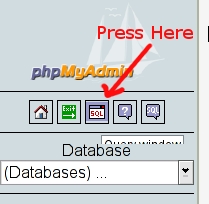Difference between revisions of "Mor user password change HOW-TO"
(Page ready for public) |
|||
| Line 12: | Line 12: | ||
Enter fallowing code SET password=password("'''YourNewPasswordGoesHere'''"); into newly appeared window and press Go. | Enter fallowing code SET password=password("'''YourNewPasswordGoesHere'''"); into newly appeared window and press Go. | ||
Example: If I want change my password to 12345 I will enter: SET password=password("12345"); | Example: If I want change my password to 12345 I will enter: | ||
SET password=password("12345"); | |||
Revision as of 10:06, 23 October 2008
Before performing any actions with password changes, please read whole topic and make sure you understand everything, cause its very important.
1. Update MySQL password:
Login to http://your.mor.server.or.ip.address.where.mor.is.installed/phpmyadmin/ using default userpass (use mor as a login and mor as a password).
Then press Query Window
Enter fallowing code SET password=password("YourNewPasswordGoesHere"); into newly appeared window and press Go.
Example: If I want change my password to 12345 I will enter:
SET password=password("12345");
2. Update system configuration files:
Login via ssh to your server and modify following configuration files:
/home/mor/config/database.yml
development: adapter: mysql database: mor username: mor password: YourNewPassword host: localhost port: 3306 test: adapter: mysql database: morcallc_test username: root password: host: localhost production: adapter: mysql database: mor username: mor password: host: localhost port: 3306
/etc/asterisk/mor.conf
[global] hostname=localhost dbname=mor user=mor password=YourNewPassword port=3306 ;sock=/tmp/mysql.sock
/etc/asterisk/res_mysql.conf
[general] dbhost = 127.0.0.1 dbname = mor dbuser = mor dbpass = YourNewPassword dbport = 3306 ;dbsock = /tmp/mysql.sock
Then perform following commands:
/etc/init.d/apache2 restart if you are running on Debian /etc/init.d/httpd restart if your Operating System is CentOS /etc/init.d/asterisk reload
Then double check if system is working correctly by using
'rasterisk vvvR'
and entering
'realtime mysql status'
debian2*CLI> realtime mysql status Connected to mor@127.0.0.1, port 3306 with username mor for 4 seconds.
If you see something similiar, that means configuration files has been updated successfully. If you still get any errors, let us know by opening new support ticket.

